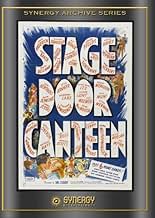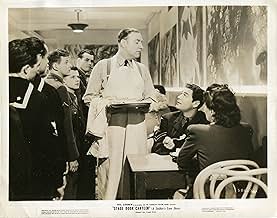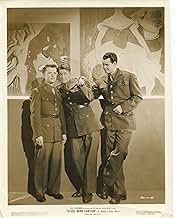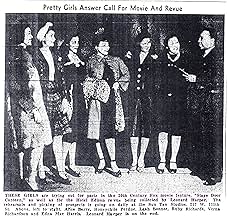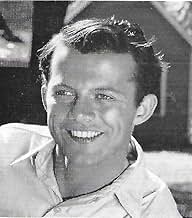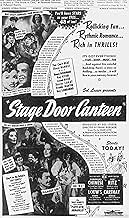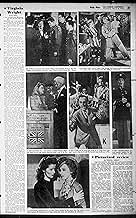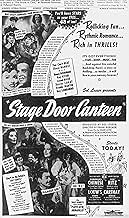Füge eine Handlung in deiner Sprache hinzuA young soldier arrives in NYC and, before heading overseas to WWII, visits Stage Door Canteen, where famous actresses and entertainers volunteer to entertain soldiers.A young soldier arrives in NYC and, before heading overseas to WWII, visits Stage Door Canteen, where famous actresses and entertainers volunteer to entertain soldiers.A young soldier arrives in NYC and, before heading overseas to WWII, visits Stage Door Canteen, where famous actresses and entertainers volunteer to entertain soldiers.
- Für 2 Oscars nominiert
- 1 Gewinn & 2 Nominierungen insgesamt
Empfohlene Bewertungen
The film is chock-full of celebrity cameos by dozens of famous stars of the stage, screen, and radio. Most of the celebrities are identified in some way, although big-time classic movie fans should have fun spotting them first.
The movie is a product of its time, and seen many decades removed from its original context it becomes something of a time capsule, showcasing the entertainment of a past generation. Some of the names will be a bit obscure to modern audiences (particularly stage stars who didn't make many movies).* Guest stars include ventriloquist Edgar Bergen, vaudeville comedian Ed Wynn, Oscar-winners Katharine Hepburn and Paul Muni, the jazz bands of Benny Goodman and Count Basie, and various Hollywood supporting players and entertainment personalities.
Where else can you see Franklin Pangborn wash dishes with jungle man Johnny Weissmuller? Other highlights are scenes between married Broadway stars Alfred Lunt and Lynn Fontanne, a rousing song by Ethel Merman, and a comic striptease by Gypsy Rose Lee (strictly rated G -- more "tease" than "strip").
Classic movie fans will get more out of this film than the uninitiated, who might not recognize the faces or even the names that go with them. The movie works best when you can appreciate the cameos.
Don't expect much in the way of plot. Comedy bits and musical numbers are strung together by a story of young soldiers visiting the Canteen on leave before being shipped overseas and the girls they meet inside. The young romances reflect the bittersweet reality of wartime relationships.
Cheryl Walker is lovely as the ice queen hostess who comes to the Canteen for all the wrong reasons. She's looking to further her own acting career and isn't particularly interested in showing the soldiers a good time. Marjorie Riordan is cute as one of the other hostesses, who spends time with a soldier who has no sweetheart back home.
STAGE DOOR CANTEEN isn't wartime escapism. Director Frank Borzage doesn't try to distract the audience from the global situation. He keeps the audience constantly reminded, with the soldiers, sailors, airmen, and Marines that populate the Canteen and the alternately upbeat and somber patriotic tunes. Amid all the star-gazing, the film comes out in support of the U.S. servicemen, as well as America's allies in combat from Australia, the U.K., Russia, and even China. It's not hard to imagine the comfort the film must have given audiences at the height of World War II.
*The similarly-themed HOLLYWOOD_CANTEEN (1944) may have more recognizable stars, boasting some of the biggest names from Warner Bros. films (Bette Davis, Joan Leslie, Joan Crawford, John Garfield, S.Z. Sakall, Ida Lupino, Jack Carson, Sydney Greenstreet, Jane Wyman, etc.).
I remember seeing it as a child in 1943 and have had it on tape for years and wonder why it has not been digitally remastered. The picture is scratchy and bumpy in parts, but nothing can spoil the innocence of our youth in uniform ready to go off to war.
Cameo appearances of so many entertainers on one stage give you an idea of what vaudeville and the big band era were like. There is no plot line or even a semblance of continuity in the performances of these stars, but all are polished appearances as if the casts were on tour. Their time was donated and their patriotism shows through loud and clear.
The story line involves a group of army enlistees who are given a mini furlough in New York City before they ship out. They are in awe of the big city at first but are told of a place where there is entertainment and free food. This, of course, is the canteen. Over the course of less than forty-eight hours, Dakota, Californa, Tex, Jersey, and others pair off with hostesses at the Stage Door Canteen. It is amazing how quickly love blooms in this setting. The hostesses have taken a vow not to get involved with the fellas, but how can they resist when they see the innocence, charm, and sincerity of the boys?
If there are starring roles in the storyline, they belong to California and Eileen, though they are not paired as sweethearts. California (LonMcAllister)looks like a teenager and is so likable. He has never kissed a girl! Eileen (Cheryl Walker) is torn between her duty to the canteen and her love for Dakota.
Some have said this movie is a morale booster or war-time propaganda. I like to think of it as the way things were during World War II.
No reason it can't be enjoyed though. Skip the slight plot involving the servicemen who are patronizing the Stage Door Canteen who hook up with the hostesses there. Concentrate on the number of stars in the film, each doing some bit of business for themselves.
Though a number of film stars are here, the film concentrates on stars of the Broadway stage. Katherine Cornell makes her one and only appearance in a film, in fact my favorite part of Stage Door Canteen is her impromptu reading from Romeo and Juliet with bashful GI Lon McCallister who played Romeo in high school. Alfred Lunt and Lynne Fontanne are here also. The Lunts later did some televised plays and we have some kinescope version of them. They eschewed the screen though, so even a bit of footage of them doing kitchen police at the Canteen we should be grateful for.
The concert violinist Yehuda Menuhin is also here and it's nice the GIs took time to hear some serious music, a break from the swing bands of the era that are featured like Count Basie, Freddy Martin, Benny Goodman, and Kay Kyser.
Director Frank Borzage was known for doing films of tender romances and the nominal leads William Terry and Cheryl Walker were little heard from again. Still they do their best to provide the note of poignancy for the serviceman enjoying time with the stars before going to war.
Funniest unintentional moment occurs when Franklin Pangborn and Johnny Weissmuller are on the serving line. Pangborn who was very close to being an out gay actor at the time is looking admiringly at Tarzan and engages in a little banter with Weissmuller. Tarzan decides things are too hot in the kitchen and removes his shirt. I thought Pangborn was going to faint on the spot.
I'm a sucker for these all star extravaganzas, I'll never give a bad review to one of them. Stage Door Canteen provides a glimpse of a bygone era, not likely to return.
Wusstest du schon
- WissenswertesThe real Stage Door Canteen at 216 W. 44th St., Times Square, was unable to be used for filming, as it was still an operating nightclub during World War II. As such, for this movie, it was re-created at R.K.O. Radio Pictures studios in Culver City, California.
- Zitate
Katharine Hepburn: He knows what he's fighting for. He's fighting for the kind of world in which you and he can live together in happiness and peace and love. Don't ever think about quitting. Don't ever stop for a minute... working, fighting,praying until we've got that kind of a world. For you, for him, for your children... for the whole human race. Days without end. Amen.
- Crazy CreditsAll rights granted by the American Theater Wing which gratefully acknowledges and credits the producers, stars and members of all the theatrical unions, guilds, crafts and associations for their participation in the creation and continuance of the original Stage Door Canteen.
- Alternative VersionenThere are two versions of this film --- one that runs two hours and twelve minutes, and a shorter television version, which runs one hour and thirty-three minutes (93 minutes), which is the most common one available.
- VerbindungenFeatured in Gotta Dance, Gotta Sing (1982)
- SoundtracksThe Girl I Love to Leave Behind
(1943)
Music by Richard Rodgers
Lyrics by Lorenz Hart
Sung and Danced by Ray Bolger (uncredited)
Reprised as dance music near the end
Top-Auswahl
Details
- Erscheinungsdatum
- Herkunftsland
- Sprachen
- Auch bekannt als
- Den stora stjärnparaden
- Drehorte
- Produktionsfirma
- Weitere beteiligte Unternehmen bei IMDbPro anzeigen
- Laufzeit2 Stunden 12 Minuten
- Farbe
- Seitenverhältnis
- 1.37 : 1
Zu dieser Seite beitragen


